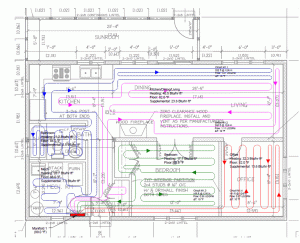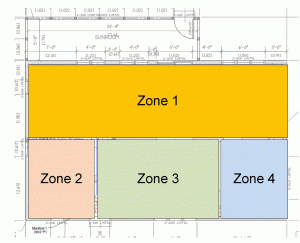
How to align expectations of hydronic systems with reality
August 29, 2018 | By Mike Miller
It is not uncommon for contractors, and sometimes consumers, to call me to complain about the performance of a hydronic system. Many of these times, if it is not system settings related, it is because the consumer is expecting different behaviour from the system.
Before dealing with the expectations issue, I believe that once a control system is properly setup and commissioned, all the kinks should have been worked out and controls should be set to run the HVAC system as required. Fine tuning of some settings may need to be made, but overall, the system should be set and run its course.
That aside, I believe that in most cases consumer dissatisfaction is due to unrealized and unreasonable expectations. As trade professionals we often forget that the vast majority of consumers have very little, if any, knowledge of our trade and its associated technologies, and how they should be running together to achieve the premier comfort.
Can we really blame them? Surely, if the consumer is not in our field of work, there are more exciting things to pay attention to, at least in their mind. It is ok to be shocked by this revelation, as I was the first time someone made me aware of this.
We can help ourselves by spending the time upfront with customers to go over the various pieces and how they will work together, so that the expectations are closer to the reality the consumers will find themselves living with down the road.
The more common complaints consumers have are, more often than not, about comfort and speed of performance.
COMFORT CONTROL IN RADIANT SYSTEMS
The lengthy response time when dealing with hydronic radiant floor heating systems is a case in point, especially if it is the consumer’s first radiant floor heating system. You will need to explain that the temperature of the fluid supplied hydronically is much lower than that of air based systems. The mass of the slab is what needs to respond to fluid temperature changes and this does take time, particularly when air temperature setback is used during periods of absence.
It is very important to highlight the recovery limitations of the radiant floor heating systems. It is best to recommend a 2F to 3F setback maximum at night or during the day when everyone is out of the house. Use thermostats or hydronic control systems with the ability to learn the rate of setback recovery and to start early in order to be recovered at a desired time to reduce the dissatisfaction due to room comfort at time of recovery.
For prolonged periods of absence, a holiday for example, when consumers tend to crank down the thermostat I would promote limiting the degree of setback to something that allows recovery within four hours.
Some of the more sophisticated control systems available today have a learning algorithm that would be compromised by many rapid and bigger changes to the system. Consumers with hydronic systems need to understand that the temperature setpoints should be changed only when necessary and then only in smaller increments.
SNOWMELT
Snowmelt systems are another pretty common call where the main complaints are operating costs and the length of time it takes to clear the surface. When digging into higher operating costs, I often find that slab melt temperature setpoints are too high. The consumer needs to understand that the greater the surface temperature is set to, the greater the energy consumption. I typically recommend keeping a snowmelt surface temperature just above freezing (36F is a setpoint I normally run with).
This takes us to the second complaint, which is the amount of time it takes for the snow to melt. With lower melt setpoints, it will take longer to melt the slab. The question the consumer needs to ask is what does he/she have more of? Is it money, or is it patience? The differences between time versus costs need to be explained at the outset.
Idling is another discussion you would want to have with the consumer. If you are idling a slab, it will reduce the melting time once the snow does land, but it will also cost a lot more to idle a slab while waiting for snow accumulation that may or may not come anytime soon. I personally do not recommend idling of snowmelt slabs to consumers for residential applications. It makes more sense in commercial applications when the speedy removal of snow is more important than the cost to get it done.
If idling of a snowmelt slab is what the consumer wants, the same principle mentioned above applies. The lower the idling setpoint, the more cost effective it will end up being. I often recommend something in the neighbourhood of 29F for an idling setpoint.
THERMOSTATS WITH SLAB SENSORS
Another common struggle seems to be thermostats with slab sensors and the temperature limits associated with them, with the common complaint being overheating and/or underheating. As soon as you use slab sensors and you set either, or both, slab minimum and maximum limits, it will compromise air setpoint as soon as one of them is reached. For example, if you have a slab minimum limit that is greater than air temperature setpoint, the air temperature may be overshot as the minimum slab setpoint takes precedent over air setpoint.
The same is true for slab maximum limit. This is the greatest temperature a slab can rise to in order to satisfy air setpoint, but it cannot go beyond. Calls regarding performance and the resulting dissatisfaction will be greatly reduced if the consumer clearly understands the purpose and functionality of slab sensors and their associated limits.
MORE ADVANCED SYSTEMS
Whatever approach the HVAC designer/installer takes to a hydronic system consisting of multiple radiant zones serviced by one air zone, thorough training of the consumer is imperative. The end result will be a happier customer and fewer service calls if you spend enough time here.
Figure 1 shows an example of a loop layout for a smaller building. Figure 2 shows the radiant zoning within the same building and Figure 3 shows the air zoning. My recommendation would be to work with a control system capable of integrating radiant and air zones together.
The system would utilize a thermostat in each of the radiant zones with one of the being a “master” that would control radiant and the air zone. They communicate with each other to best harmonize the needs of the radiant system with the air system.
Systems such as this allow the radiant to operate independently across all stats, but when it comes to the control of the air zone, the master would take over and control it.
In many of these systems, the consumer is often confused about how the radiant thermostats interact with the thermostat controlling the air zone. An air zone thermostat’s operation could be suspended for cooling if a radiant thermostats needs heat at the same time. Understanding the limitations and strengths of this kind of system will take time, but it is invaluable.
INTERNET OF THINGS (IOT)
As more options are available and will be available moving forward, it is even more important to explain to your consumer when and how they should be using the remote connectivity feature of the new devices entering our businesses. Only because we ‘could’ change things remotely, does not mean we ‘should.’ There are times when it makes sense to make changes to comfort settings, but those are usually limited to returns from holidays/longer periods of absence, or, to start certain devices in the building prior to needed use, such as pools and hot tubs.
Suggest to the consumer that the remote connectivity should be mainly used for monitoring of the systems. If at all possible, I would even recommend limiting the adjustment capabilities to the consumer as much as possible. Give them what they need, but whenever possible make sure you eliminate system critical settings that could compromise the system’s functionality. Also, make sure that you understand for yourself and then clearly explain to the consumer, the IT related requirements to have these systems remotely accessible. Many of those needs do not fall into our typical day-to-day expertise either.
As is the case with many things, there are many opportunities to save our future workload by putting in the necessary time at the beginning to educate the consumer. This will only help you by leaving you with less support needs and customers who will recommend your services to others.
Mike Miller is director of sales, commercial building services, Canada with Taco Inc. and a past chair of the Canadian Hydronics Council (CHC). He can be reached at hydronicsmike@tacocomfort.com.







